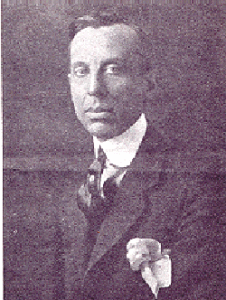“The Automobile Industry’s GIANTS”
A HISTORY OF AMERICAN BUSINESS
~The Rise of Detroit ~ By John Chamberlain
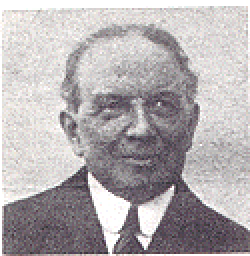 William C. Durant |
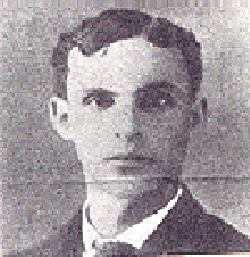 Henry Ford |
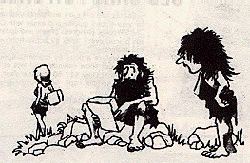 “Car Insurance?…You bought car insurance?” |
Durant’s folly — the dream of 500,000 cars.
Duryea’s bugyaut and the Merry Oldsmobile.
An enduring export: mass production .
Ford’s Model T rolls and reigns supreme for 18 years.
The Chevy and Chrysler’s Plymouth move up
An enduring export: mass production
T he destined founder of General Motors, William Crapo Durant, for whom the phrase “live wire” seems specifically to have been invented, was approaching forty when the twentieth century opened. The grandson of a lumber tycoon who had been the Civil War governor of Michigan, Billy Durant made his first million dollars in the carriage business in Flint. Thoroughly bored with the success of his Durant-Dort Carriage Co., he went off to New York to study the stock market, but a hurry call brought him racing back in 1904 to save his home town from a threatened business catastrophe. The automobile company started by David Dunbar Buick, a plumbing-supply man, was on the rocks–and Durant, as the wealthiest man in Flint, was asked to take it over.
Billy Durant knew nothing about automobiles. But he had been making a study of the trust movement, and he had big ideas: he wanted to become a Napoleon in some line of work. Getting himself one of the fifty-tree Buicks that had been made in two years of the company’s existence, he took off through the sand and mud of Michigan’s cutover forest region to assure himself that he had a salable product. The Buick was probably no better and no worse than cars that were already being made in Detroit by Henry ford, or in the state capital of Lansing, by Ransom Eli Olds, or by the precursors of the Willys-Overland company in Indianapolis, or by Alexander Winton in Cleveland, or by Thomas B. Jeffery in Kenosha, Wisconsin, who had already made money from the Rambler Bicycle. It was the standing vaudeville joke of the times that for every hour devoted to coaxing speed from a primitive carburetor over bone-rattling roads at least two hours must be spent flat on one’s back underneath the machine. The vaudevillians couldn’t decide whether “get out and get under” or “get a horse” represented the utmost in derision as rubes seated on roadside fence rails tossed their taunts at the city slickers who had begun invading the countryside in their snorting devil wagons.
But Durant, an incorrigible optimist, was oblivious to irony. he decided that the Buick, which boasted a valve-in-head engine, was good enough to support his ambitions, and he poured enough money into the staggering company to buy personal control of it. Within two years he had raised Buick production from the sixteen or twenty-eight cars of 1904 (the accounts of the year differ) to the 2,295 of 1906. He had enticed an axle company to move all the way from New York State to Flint, to become his exclusive supplier, and he had made a deal with Albert Champion, the French racing driver, to make his new AC porcelain spark plug for Buick. The capitalization of Buick had been increased from $75,000 to $1,500,000 by Durant’s daring stock salesmanship, with flint citizens subscribing half a million in a single day. The town of course boomed: to house the influx of Buick workers, Flint rooming-house proprietors began renting their beds in two shits as the population proceeded to double in five years.
BUICK MODEL B. ![]()
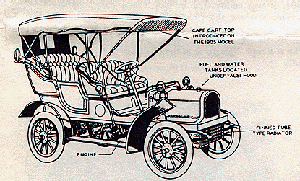 The very first production Buick automobile was built in 1904 after David Buick had built sixteen by a experimental vehicles during the previous year. It was powered by a 22-hp., two cylinder, valve-in-head, centrally located, water-cooled engine fitted with planetary gears. Two forward speeds and reverse were available. final drive was by a chain to the rear wheels.
The very first production Buick automobile was built in 1904 after David Buick had built sixteen by a experimental vehicles during the previous year. It was powered by a 22-hp., two cylinder, valve-in-head, centrally located, water-cooled engine fitted with planetary gears. Two forward speeds and reverse were available. final drive was by a chain to the rear wheels.
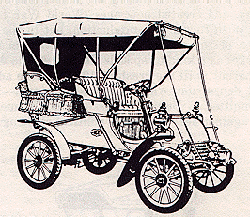
![]() CADILLAC MODEL A. This is considered to be the first Cadillac automobile offered to the public, and the price was $800 in 1903. The design was developed in 1902 and was fitted with a single-cylinder, water-cooled, 98-cubic-inch-displacement engine that was built by Leland & Faulkner. It was centrally located, horizontally, with the cylinder facing to the rear.
CADILLAC MODEL A. This is considered to be the first Cadillac automobile offered to the public, and the price was $800 in 1903. The design was developed in 1902 and was fitted with a single-cylinder, water-cooled, 98-cubic-inch-displacement engine that was built by Leland & Faulkner. It was centrally located, horizontally, with the cylinder facing to the rear.
1908, OAKLAND ![]()
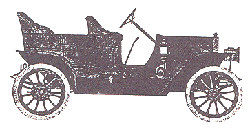 2-cylinder water-cooled engine, 20 h.p. Epicyclic gear box with 2 speeds. USA
2-cylinder water-cooled engine, 20 h.p. Epicyclic gear box with 2 speeds. USA
Intoxicated with his success, Billy Durant moved ahead in 1908 with his idea of creating an automobile trust. Lacking sufficient cash to buy out Henry Ford or Ransom Olds, he journeyed east with Benjamin Briscoe of the Maxwell-Briscoe Co., and announced himself at J. P. Morgan & Co. with a boast that the time would come “when half a million automobiles a year will be running on the roads of this country.” Curiously, this raised the hackles of Morgan partner George W. Perkins, the apostle of the “good trust,” who promptly left the room. “If that fellow has any sense,” Perkins, “he’ll keep those observations to himself.” But Perkins was wrong and Billy Durant was right in his analysis of the future of America.
Unable to raise capital on Wall Street, the irrepressible Billy went back home and put together the combination of General Motors anyway.
G. M. which in 1960 boasted sales of over $12 billion, wasn’t much in 1908 when its total capital amounted to only $2,000. Shortly, however, it swallowed up the Oldsmobile, the Oakland (now the Pontiac), and the Cadillac companies in addition to Durant’s own Buick. Eventually it added Chevrolet to its empire–and with the relatively low-priced Chevy it finally outstripped Henry Ford. To harmonize its bulky components G.M. was forced to experiment with new managerial techniques in the realm of manufacturing. It was not the progenitor of “bigness” as such–that accolade, as we have seen, goes to Standard Oil and U.S. Steel. But in its ability to reconcile decentralized diversity of product (it was also to go into electric refrigerators and diesel engines in a later phase) with management control from the top, and to combine manufacturing skills with a scientific approach to marketing, G.M. set a new style and tone in American enterprise. By the late Twenties it had begun to symbolize the automobile and automotive age itself.
The history of U.S. business from the turn of the century through the Twenties cannot, of course, simply be tagged f.o.b. Detroit. The U.S. had its heavy industries well before the coming of the car, and Edison’s breakthroughs in electricity were bound to transform American life in any case. Nevertheless, the automobile ballooned payrolls in steel, rubber, flat glass, and aluminum and helped turn places like Akron, Ohio, from small towns into burgeoning industrial cities. The car created the modern suburb, changed the nature of the real-estate market, sparked new methods of consumer finance, obliterated old landmarks, and created new ones. World War I gave a powerful push forward to production, but in the unfolding drama of the century’s economic development it at firs appears as a kind of episode. Its full effects ere not to be apparent until the crash of 1929 and the advent of the great depression, when American business–by then fully committed to Detroit’s mass-production methods–came up against new social and political challenges.
The early landscape
DURYEA CAR ![]()
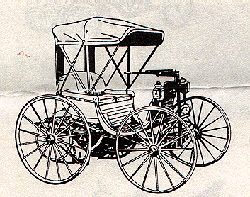 James Frank Duryea and Charles Edgar Duryea, brothers, ran their first vehicle on September 22, 1893, through the streets of Springfield, Massachusetts. It was America’ first successful “gas” car, with a single-cylinder, four-stroke, water-cooled gasoline engine. An 1893 Duryea is in the Smithsonian Institute, in Washington, D.C
James Frank Duryea and Charles Edgar Duryea, brothers, ran their first vehicle on September 22, 1893, through the streets of Springfield, Massachusetts. It was America’ first successful “gas” car, with a single-cylinder, four-stroke, water-cooled gasoline engine. An 1893 Duryea is in the Smithsonian Institute, in Washington, D.C
WINTON, 1895/6. ![]()
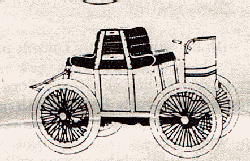 Alexander Winton’s first car, 1985/6 Winton was one of the foremost makes in America in the early years of motoring.
Alexander Winton’s first car, 1985/6 Winton was one of the foremost makes in America in the early years of motoring.
HAYNES’S FIRST![]()
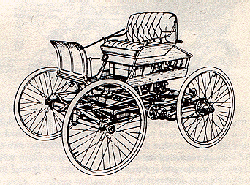 An outstanding metallurgist, Elwood G. Haynes of Kokomo, Indiana, drove his original design on the Fourth of July, 1894. It was constructed by Edgar and Elmer Apperson in their Kokomo machine shop; assisting was Jonathan D. Maxwell. Initial power, a one-cylinder gas engine made by Claude Sintz of Grand Rapids, Michigan, sped the 820-pound vehicle along the Pumpkinvine Pike at 6 mph. The car is in the Smithsonian Institute, Washington, D.C.
An outstanding metallurgist, Elwood G. Haynes of Kokomo, Indiana, drove his original design on the Fourth of July, 1894. It was constructed by Edgar and Elmer Apperson in their Kokomo machine shop; assisting was Jonathan D. Maxwell. Initial power, a one-cylinder gas engine made by Claude Sintz of Grand Rapids, Michigan, sped the 820-pound vehicle along the Pumpkinvine Pike at 6 mph. The car is in the Smithsonian Institute, Washington, D.C.
These developments lay some distance ahead when in 1908 Billy Durant was cold-shouldered by the House of Morgan on the automobile’s potential. Durant did not preside at the birth of the automobile. Credit for making the first U.S. gasoline-driven car has generally been accorded to the Duryea Brothers, Charles E. and J. Frank, of Springfield, Massachusetts, whose “buggyaut” made its first public street run in September of 1893; and the second American car was probably made in 1894 by Elwood Haynes of Kokomo, Indiana. In his book My Life and Work, written with Samuel Crowther, Henry Ford challenges these claims by stating that his first successful car was rolled out of a brick shed in back of his home on Bagley Ave., Detroit, in the spring of 1893: but historians are inclined to think that his initial breakthrough came some three years later. Actually the whole argument about the “first” American car is a bit academic, for Europe led the way. In 1885, Gottlieb Daimler of Germany designed an internal-combustion engine driven by gasoline fuel on which their development of the modern automobile depended, and early European carmakers included Levassor, Panhard, and Benz. French cars in particular were initially popular with the rich of Newport, and their import helped domesticate words like “chauffeur” and “garage,” “tonneau” and “automobile” itself in the American language.
T he reputedly idle rich also financed automobile racing, which led to improvements in engine compression, and the durability of tires, and they helped organize the first U.S. auto- mobile show at Madison Square Garden in 1900. Other things besides a rising “moneyed” and middle class were favorable as the century opened. The gasoline engine was to prove a compact and efficient power plant, which soon dominated the field despite the early vogue of electrically propelled vehicles and the formidable Stanley and White and Winton “steamers.” Gasoline itself, for years an unused byproduct of kerosene, became cheap and plentiful. Carriage makers like Studebaker and the Fisher brothers readily reapplied their skill in the new horseless age. Perhaps most important, America was blessed with an inspired generation of mechanics who had put some 12 million bicycles on the road between 1880 and 1900. It was, in fact, two of these bicycle mechanics, Orville and Wilbur Wright, who in 1903 astounded the world by their pioneering flight at Kitty Hawk on the North Carolina dunes.
But if the times were propitious for technological change, there remained the disconcerting fact; that the U.S., even well into the 1900-10 decade,” consisted of two civilizations, each of which seemed permanently walled off from the other. The towns were railroad connected, but the American highway system had undergone a marked retrogression since the days of the first toll roads. Everywhere in eastern and middle America the country roads were impossible quagmires in early spring; in summer there was dust and deep ruts to contend with; in winter ice and snow frustrated the smooth tires of the time. Rich townsfolk, hankering for the nostalgic pleasures of the countryside, might dare these inconveniences first on bicycles and then in the early cars, equipping themselves with goggles and dusters. Farmers, who couldn’t afford the first cars anyway, were not disposed, however, to vote a nickel for surfaced roads to help the pioneering Detroit and New England automobile “crackpots.” Yet paradoxically it was rural America that needed cars far more than the city slickers who bought the first models.
End of Part One.
Part Two. Enter Mr. Olds.
Ransom E. Olds made America’s first mass-produced car in 1900. This 1902 model Oldsmobile Followed the “curved dash” motif of many of his early designs. It was fitted with a one-cylinder gasoline engine, and a 2 speed planetary transmission and chain drive to the rear wheels. 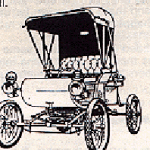 The finned-coil radiator was fitted under the curved dash.
The finned-coil radiator was fitted under the curved dash.
The difficulties of bridging rural and urban America are well illustrated by the early career of Ransom Eli Olds, who, without disparagement to Henry Ford, was the first man to try to give the farmer what he needed. A machinist, who had built a three-wheeled, steam-driven road vehicle as early as 1893, “Ranny” Olds had persuaded a Michigan copper- and-lumber millionaire, Samuel L. Smith, to finance the Olds Motor Works in Detroit in 1899. (Of $200,000 in paid-in capital, Olds himself contributed $400 and Smith the remainder.) Olds had it in mind to produce a one-cylinder buggy to retail for less than $700. Just as he was ready to begin its manufacture, the Olds factory in Detroit burned down; but the single completed model of the “curved dash” runabout–the “Merry Oldsmobile” of the popular song–was saved from the flames by a brave timekeeper. Without factory resources at his command. Olds proceeded to farm out the manufacture of his engines and parts to various firms in Detroit, moving his own assembly operations back to his home town of Lansing. Here he put together 600 of the “curved dash” economy models in 1901, 2,600 in 1902, 4,000 in 1903, and 5,000 in 1904.
This, if not mass production, was at least quantity production. But the farmer, as it turned out, could not make any particular use of the cheap curved-dash Oldsmobile because of its flimsy construction. In a race to get his car to New York in 1901 in time for the automobile show, an Olds driver, twenty-one-year-old Roy D. Chapin (later’ the boss of Hudson and a Cabinet officer under Hoover), had to leave the jolting, muddy highways of interior New York and take to the relatively smooth towpath of the Erie Canal, where he was held up by the mules. He managed to reach the door of the Waldorf-Astoria in seven and one-half days, so dirty and disheveled that he was shunted by a suspicious doorman to the service entrance.
Not liking the long-term prospects of a car that had to seek out canal towpaths, copper man Smith insisted that Old return to heavier and more expensive makes. Because of their basic disagreement. Olds departed from the company–which, however, would carry his fame through the years in the name of a G.M. division.
Other tinkerers backed by shoestring financiers were rapidly to appear and disappear on the American scene. The automobile graveyard is dotted with the names of hundreds of cars–Altham, Ajax, Crestmobile, Grant-Ferris, Lear, Mohawk, Niagara, Regas, Waterloo, Wolverine, Yale, Zentmobile are a few early casualties–that were never much more than a gleam in a mechanic’s eye. But Boy Chapin and Howard Earle Coffin, graduates of the original Olds company, got the Hudson Motor Co. going with the help of $60,000 provided by Detroit department-store owner W. S. Hudson. John North Willys, a bicycle salesman, took the $80,000 of debts that represented the Overland Co. of Indianapolis, shifted the company’s production to Toledo–and was off winging on the basis of the trust dealers and parts makers were willing to repose in his new Willys-Overland model. The success of Willys, which led to the parallel success of the Electric Auto-Lite Co., quickly turned Toledo from a sleepy town into a modern manufacturing community. The Studebakers of South Bend, Indiana, convinced that wagons were on the way out, made a few cars on their own and acted as sales agent for a shoestring company called E-M-F, which had made $1,600,000 on 8,312 automobiles during the first seventeen months of its existence. Emboldened by the earnings on their stock interest in the E-M-F, the Studebaker company soon took over its manufacture. Packard was started in Warren, Ohio, by a cable manufacturer and was subsequently moved to Detroit by Henry Joy, the son of a Michigan Central Railroad lawyer. With capital provided by Detroiters, Joy made $1,300,000 on 1,188 expensive Packards in the single depression year of 1907.
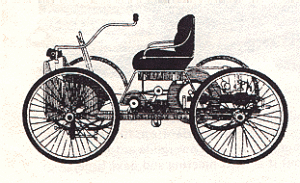 The man from Dearborn FORD’S FIRS FORD 1896. Ford’s first original autocar (experimental) car was built by hand, in 1896 2-cylinder horizontal engine. Was little more than a motorized buggy. Two speed primary drive by belts and jockey pulleys. No brakes. No reverse gear. Top speed about 17 m.p.h.
The man from Dearborn FORD’S FIRS FORD 1896. Ford’s first original autocar (experimental) car was built by hand, in 1896 2-cylinder horizontal engine. Was little more than a motorized buggy. Two speed primary drive by belts and jockey pulleys. No brakes. No reverse gear. Top speed about 17 m.p.h.
But it was the coming in 1908 of Henry Ford’s cheap and sturdy Model T that made the car available to all classes and that finally broke down the barrier between urban and rural America. The Ford saga has been told many times and from many angles, with Henry Ford himself providing a neat, rational explanation for every major decision made by his company. That the reasons were, for the most part, ex post facto, as is claimed by Ford’s man Charles Sorensen, hardly makes any difference, for Ford, until he grew old and cantankerous, was a brilliantly intuitive man. Like an inspired somnambulist, he felt his way to his goals without knocking over the tables and the crockery. As the son of a Dearborn, Michigan, farmer, he hated farm work, preferring to hang around the blacksmith shop. In the late Eighties he made himself a steam car that ran, hoping to pull his own plow with it, but was forced to discard it as unsafe. He also built himself a miniature four-cycle gas engine, which he gave away. Living in Detroit as engineer and machinist for the Edison Illuminating Co., he angered his electricity-minded employer by continuing to experiment with gas engines. Though he won some fame as a racer with his own model, beating Alexander Winton at the Blue Ribbon Race Track in Grosse Pointe in 1901, he was still a seedy business failure at forty. A lumber dealer, William H. Murphy, had backed him successively in the Detroit Automobile Co. in 1899 and in the Henry Ford Automobile Co. in 1901. But when both companies failed to produce, Murphy broke with Ford and. turned to Henry Leland, a veteran precision-tool maker and apostle of interchangeable parts who had worked as a young man in the Colt gun factory in Connecticut and in the Brown & Sharpe Manufacturing Co. in Providence. Leland and Murphy promptly changed the name of the first Henry Ford company to the Cadillac Automobile Co.
T he day was saved for the disgruntled Ford when Barney Oldfield, a professional bicycle racer, won a second race from Alexander Winton at the tiller of a specially built Ford “999,” which developed 80 hp. Seated at the race track that day was Alexander Y. Malcomson, a Detroit coal dealer, who decided that he might well overlook the business failures of a man who could design so powerful a car. Malcomson brought others with him into the venture of giving Ford in 1903 a third shot at the manufacturing business: John S. Gray, a candy manufacturer
and local bank president, took 105 shares and put in $10,500 in immediate cash; James Couzens, Malcomson’s Canadian-born bookkeeper, added a borrowed $1,500 to his $900 savings for twenty-four shares; Couzens’ school-teacher sister Rosetta put in $100 for one share; two Malcomson-coal-company lawyers, John W. Anderson and Horace Rackham, invested $5,000 each; Albert Strelow, a carpenter, took fifty shares valued at $5,000 for providing the new company with the use of a one-story build-ing; and the Dodge brothers, Horace and John, each got fifty shares for quitting Ransom Olds and devoting their parts-supply business to Ford. As for Malcomson and Ford, they assigned themselves 255 shares each.
With this capital in hand. Ford began feeling his way to producing a really cheap and durable car. One thing that helped him along was a chance occurrence in 1905 when he witnessed the smashup of a French car at the Palm Beach race track. Noticing a shining piece of valvestrip stem lying near the wreck. Ford picked it up. It seemed both light and strong- -and, when analyzed, it proved to be vanadium alloy steel, which had not yet been made in America. This gave Ford his cue. Finding a company in Canton, Ohio, that was willing to make the unfamiliar alloy. Ford had the basic material he needed for the Model T. During the 1908-09 season the Ford company continued to produce other models. But the Model T, as Ford himself put it, soon “swept them all out.” Originally priced at $825 for the roadster and $850 for the touring car, it began an astonishing eighteen-year career with prices on some models eventually lowered to as little as $260. Production actually increased during the early years of World War I, though after America’s entry Ford turned increasingly to the output of Eagle Boat subchasers and other war material. Late in 1918, Bernard Baruch, then head of the War Industries Board, threatened to cut Ford and other automobile makers off from their supply of steel. But the war was over before the threat materialized and the Model T rolled on to make Ford a billionaire.
While the key to Ford’s success was his ability to ferret out the mass market, other things also contributed. At the very beginning he and Couzens decided not to pay royalties on the famous Selden patent under which U.S. internal-combustion car engines were originally made, a decision upheld after a long court fight. For the rest Ford, never himself much more than a cut-and-try mechanic, borrowed heavily from others. “The principles of mass production for which Ford has been given so much credit were well known before the Model T got started. The Pope Manufacturing Co. of Hartford had organized the production of bicycles and electric cars by assigning individuals to single repetitive tasks; Henry Leland of Cadillac had pioneered in the matter of interchangeable parts; and Olds and Durant were both ahead of Ford in making lavish use of suppliers. It was Walter E. Flanders, a hard-living, hard-drinking genius, who started Ford on the way to the modern assembly line by rearranging the machines at the Piquette Ave. plant in 1908. The moving production line, which was introduced at the Highland Park factory in 1913-14, and which was later carried to incredible pitches of assembly and subassembly refinement, was the work of many men including C. W. Avery, William Klann, Carl Emde, Charles E. Sorensen, and William Knudsen. Ford design, always more utilitarian than aesthetic, owed as much to the metallurgist C. Harold Wills as to Ford himself. In economic matters Ford’s decision to raise the minimum wage to $5 per day has been attributed (with no direct denial by Ford himself) to his partner Couzens, who had become appalled by the inefficiencies created by labor turnover.
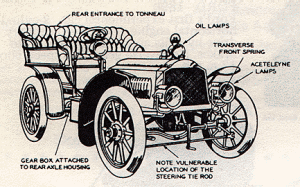 This product of the Packard Motor Car Company appeared in mid-1904 and was classed as a five-passenger tonneau. It weighed 1,900 pounds and had an aluminum body on a pressed steel frame. The detachable canopy was fitted with a glass front, which gave the passengers a great measure of comfort. The engine was four cylinders, water-cooled, vertical, 22 hp., located in front. Three forward speeds plus reverse were obtainable via sliding gear with a bevel-gear final drive. Brakes were fitted to the rear wheels and were the expanding type. the wheelbase was 94 inches and the tread was 56.5 inches. It was the start of the Packard luxury cars.
This product of the Packard Motor Car Company appeared in mid-1904 and was classed as a five-passenger tonneau. It weighed 1,900 pounds and had an aluminum body on a pressed steel frame. The detachable canopy was fitted with a glass front, which gave the passengers a great measure of comfort. The engine was four cylinders, water-cooled, vertical, 22 hp., located in front. Three forward speeds plus reverse were obtainable via sliding gear with a bevel-gear final drive. Brakes were fitted to the rear wheels and were the expanding type. the wheelbase was 94 inches and the tread was 56.5 inches. It was the start of the Packard luxury cars.
1904 CADILLAC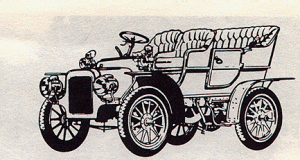 This Cadillac was built in 1904, five years before the company joined General Motors. The Cadillac Automobile Company was managed by Henry Martin Leland, a skilled engineer, who guided the general design of all models concentrating on passenger comfort and safety. This 1904 Cadillac was exported to many countries, and from 1904 to 1907 it was the most popular taxi in Stockholm, Sweden. A one-cylinder, water-cooled engine was centrally mounted and drove the rear wheels by a chain.
This Cadillac was built in 1904, five years before the company joined General Motors. The Cadillac Automobile Company was managed by Henry Martin Leland, a skilled engineer, who guided the general design of all models concentrating on passenger comfort and safety. This 1904 Cadillac was exported to many countries, and from 1904 to 1907 it was the most popular taxi in Stockholm, Sweden. A one-cylinder, water-cooled engine was centrally mounted and drove the rear wheels by a chain.
End of Part Two.
Part Three. Ford goes it alone
But it was Henry Ford who fused all these ideas together. In the end he not only outstripped all competitors but also acquired the means to buy out every last one of his financial partners. Strelow, the carpenter, and Malcomson both sold out early. Couzens left the company in 1915, not because of any business-policy discord, but simply because he couldn’t abide Ford’s pacifistic attitude toward the war in Europe. When Ford eventually arranged to take over Couzens’ stock in 1919, he paid $40 million for it (and Couzens had already had $ll million in dividends on his early investment of a very few thousand). Couzens’ sister Rosetta, who sold out at the same time, collected $265,000 on her original $100, which had already brought her $90,000 in dividends. The estate of candy-maker Gray got $26 million on the original $10,500. As for Horace and John Dodge, who had precipitated Ford’s decision to get rid of his minority stockholders by suing him for a distribution of earnings and by enjoining him from going ahead with the decision to build the big steelworks at the River Rouge in Dearborn, they departed with $12,500,000 each. They had already had more than $17 million each in dividends, much of which they had put to work in their own Dodge Motor Co., whose sturdy cars provided some competition for the Model T even though they were in a higher price range.
The financial strain on. Ford that had been caused by buying his partners’ stock and by building the huge plant at the Rouge was compounded by the 1920-21 postwar depression, but the Ford Motor Co. survived without giving hostages to the bankers, whom Ford always detested. Ford squeaked through by going full steam ahead with his factory runs and shipping huge numbers of cars — for cash — to his dealers, whose local credit was sufficient to carry them through the short depression period. The dealers groused about being badly used, but they had made such a good thing out of the Ford franchise for twelve golden years that virtually none of them cared to risk losing favor with the Dearborn autocrat. And what they lost in 1920-21 they soon recovered in 1922-24, when the Model T sold better than ever. Indeed, in 1924 Ford production ran to 1,600,000 units, representing a 51 per cent “penetration” of the total U.S. car market.
Self-starter for the ladies
This, however, was the high point of popularity for the famous’ Tin Lizzie, and well before this the tide had subtly begun to change. The Model T was the farmer’s friend because of its durability, and in a masculine world it reigned supreme. But by the Twenties — and even before — the American housewife had become a powerful factor in car buying, demanding amenities that Ford was reluctant to offer. Among the amenities was a self-starter, which was ultimately to replace the hand crank on all cars. Ford remained impervious to the general upgrading in quality, but other manufacturers, notably General Motors, capitalized on the new trend and eventually upset Ford’s hold on the family car market.
G. M. itself had its full share of early growing pains, partly because Durant, while bringing together Buick, Oldsmobile, and Cadillac, had also cumbered it with many an unprofitable I cat and dog. In 1910, two years after he put the combination together, Durant himself lost control of it to Lee, Higginson & Co. of Boston and J. & W. Seligman of New York. But the representative of bankers on the G. M. board, James J. Storrow, happened to have an interest in technology as well as in sound financial management. On the advice of Arthur D. Little Inc. of Cambridge, Massachusetts, Storrow set up the General Motors Research Department, which was to pay off fabulously over the years. He also gave Charles W. Nash his head as president of the company and Nash in turn made Walter Chrysler — a railroad mechanic with a smattering of engineering knowledge learned from the International Correspondence School — the boss of Buick. Most important in a time of shakedown and change, Storrow had the good sense to continue Henry Leland in power at Cadillac and to heed his advice to keep G.M.’s divisional structure.
Henry M. Leland & Charles Kattering 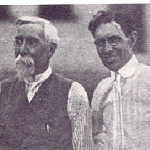 By then a white-bearded patriarch of impressive mien, Leland had a bad conscience because a good friend had been killed in the attempt to crank a balky car for a lady. This constituted a blot on the entire automobile business, which Leland was resolved to wipe out. Accordingly, he gave Charles F. Kettering of Dayton, Ohio, a commission to come up with a practical electric self-starter. Kettering had designed small electric motors for cash registers when in the employ of the National Cash Register Co. of Dayton, and, using an old barn as headquarters, he had recently formed the Dayton Engineering Laboratories Co. When Kettering offered some blueprints of a small motor designed to replace the hand crank, most experts were of the opinion that the device wouldn’t work. But Leland persisted in spending money on Kettering’s experiments, and on February 27, 1911, the first Delco self-starter sparked a Cadillac motor. Leland promptly gave Kettering a contract for 4,000 self-starters even though the Dayton Engineering Laboratories had no manufacturing facilities. “Ket,” as was to be his habit, carried the assignment through, thus forming a tie with G. M. that as the years went by was to prove more and more fruitful in all departments of engineering.
By then a white-bearded patriarch of impressive mien, Leland had a bad conscience because a good friend had been killed in the attempt to crank a balky car for a lady. This constituted a blot on the entire automobile business, which Leland was resolved to wipe out. Accordingly, he gave Charles F. Kettering of Dayton, Ohio, a commission to come up with a practical electric self-starter. Kettering had designed small electric motors for cash registers when in the employ of the National Cash Register Co. of Dayton, and, using an old barn as headquarters, he had recently formed the Dayton Engineering Laboratories Co. When Kettering offered some blueprints of a small motor designed to replace the hand crank, most experts were of the opinion that the device wouldn’t work. But Leland persisted in spending money on Kettering’s experiments, and on February 27, 1911, the first Delco self-starter sparked a Cadillac motor. Leland promptly gave Kettering a contract for 4,000 self-starters even though the Dayton Engineering Laboratories had no manufacturing facilities. “Ket,” as was to be his habit, carried the assignment through, thus forming a tie with G. M. that as the years went by was to prove more and more fruitful in all departments of engineering.
FORD TOURING.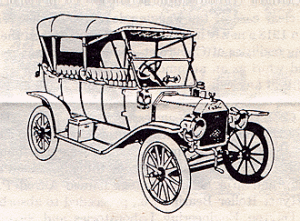 By1913 the Model T was four years old and was destined to remain in production for fifteen more years with plants in the U.S. A., Canada, and England. Over 15 million were made and sold! Although the Model T was produced in a wide variety of bodies from roadsters to buses and trucks, the favorite seems to have been the routing style of which the 1913 version is shown here. The Model T was one of the first cars to use left-had steering, the first to employ a mono-bloc cylinder casting and detachable cylinder heads cast as a unit. The use of vanadium steel allowed a slimmer chassis structure, which proved its ability to endure unlimited punishment. CHEVROLET NO. 1
By1913 the Model T was four years old and was destined to remain in production for fifteen more years with plants in the U.S. A., Canada, and England. Over 15 million were made and sold! Although the Model T was produced in a wide variety of bodies from roadsters to buses and trucks, the favorite seems to have been the routing style of which the 1913 version is shown here. The Model T was one of the first cars to use left-had steering, the first to employ a mono-bloc cylinder casting and detachable cylinder heads cast as a unit. The use of vanadium steel allowed a slimmer chassis structure, which proved its ability to endure unlimited punishment. CHEVROLET NO. 1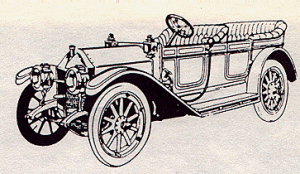 This touring five-seater was the very first Chevrolet to be produced. In 1909 William C. Durant, one of the founders of G. M., sponsored some automotive experiments. Among them was the design and testing of a new automobile being conducted in Detroit, by the famous Swiss engineer, and racing driver Louis Chevrolet. Their combined efforts resulted in the first “Chevy,” called the “Classic Six,” which was offered to the public in March, 1911. It was also offered as a “Light Six.”
This touring five-seater was the very first Chevrolet to be produced. In 1909 William C. Durant, one of the founders of G. M., sponsored some automotive experiments. Among them was the design and testing of a new automobile being conducted in Detroit, by the famous Swiss engineer, and racing driver Louis Chevrolet. Their combined efforts resulted in the first “Chevy,” called the “Classic Six,” which was offered to the public in March, 1911. It was also offered as a “Light Six.”
Durant’s second whirl.
But it was not just G.M.’s technical know-how that was to prove decisive for its success. During the years of World War I it acquired both the car and the strong financial backing that were to make it the leader of the industry. Once more the story turns on the queer and volatile character of Durant. Banished by the bankers from the management of G. M., Durant nevertheless held on to his stock, and, equally important, acquired the rights to manufacture a car designed by a French racing driver, Louis Chevrolet. Using the Chevrolet Motor Co. of Delaware as a holding company for various activities including the production of Chevrolet cars, Durant steadily increased his holdings of G. M. by exchanging Chevrolet shares for G. M. stock. Presently he scented some powerful competition coming out of Wilmington where the du Ponts, who had profited heavily in 1914 and 1915 by the sale of powder to the Allies, were plowing their capital into G. M. In 1915, Pierre du Pont became chairman of G. M. and the rule of the bankers was brought to an end. But actual control of G. M. resided in Durant’s Chevrolet Motor Co. — a clear of tail wagging dog. In a further reorganization in 1918 a newly incorporated G. M. absorbed the manufacturing facilities of Chevrolet — and Durant was ready for a second whirl as an automotive Napoleon.
Bearful of any ride on a Durant rocket, Nash and Leland both chose to quit, the one going to the newly formed Nash Motor Co. of Kenosha (successor to the Jeffery Co. and parent of the modern American Motors Corp.), and the other to form the Lincoln Motor Co., which was later bought by Ford. But Durant, recognizing a good thing in Leland’s friend Kettering and in a Leland protégé named Alfred P. Sloan of the Hyatt Roller Bearing Co., proceeded to absorb “Boss Kets” Dayton Engineering Laboratories and Sloan’s own Hyatt into General Motors. Along with Delco and Hyatt, Durant picked off the New Departure Manufacturing Co., maker of ball bearings, and arranged for the purchase of a controlling interest in the Fisher Body Co. of Detroit. He also picked up the Guardian Refrigerator Co., which was to make the Frigidaire. And in 1919 he started the General Motors Acceptance Corp., which was to play such a large role in the development of mass installment selling.
End of Part Three.
-3-
Part Four Enter Du Pont.
Thus, as the Twenties opened, the outlines of a new kind of automobile company, of a broad line of cars, and with its fingers in all kinds of subsidiary equipment, were plainly discernible. Durant himself was not to enjoy the payoff. Sales of all G.M. ears slacked off in the recession of 1920 – 21 and G. M. stock plummeted. Durant sought to support the market into which he had enticed his friends by buying heavily on margin, but soon reached the end of his resources. Fearing that his- bankruptcy would hurt G. M., Pierre du Pont and his lieutenant, John J. Raskob, committed the du Pont Co. late in 1920 to purchasing Durant’s 2,500,000 shares. With previous acquisitions, this gave du Font a 27 percent interest in G. M. — an interest it is now being forced to relinquish under recent antitrust decisions. Considered risky at the time. the investment netted the du Ponts millions. Durant himself was not so fortunate. Overtaken finally by bankruptcy in the Thirties, he never to get a third chance in the big auto combination that his optimism had put together. Significantly, when he died in 1947 at eighty-six, he was trying to a comeback as one of the earliest supermarket promoters.
DU PONT MODEL G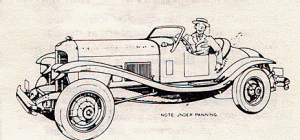 The Du Pont firm of Wilmington, Delaware, had a considerable financial interest in G.M. The Du Pont company also built cars from 1919 to 1931. This is the well-known Du Pont Model G Speedster made in 1929. It was powered by an eight-cylinder, inline, water cooled, L-head, 114-hp., 322-cubic inch displacement continental engine. The two-seater body was mounted on a 122-inch wheelbase. A Warner four speed transmission was fitted, with the fourth gear direct to the rear axle. Speed was about 100mph.
The Du Pont firm of Wilmington, Delaware, had a considerable financial interest in G.M. The Du Pont company also built cars from 1919 to 1931. This is the well-known Du Pont Model G Speedster made in 1929. It was powered by an eight-cylinder, inline, water cooled, L-head, 114-hp., 322-cubic inch displacement continental engine. The two-seater body was mounted on a 122-inch wheelbase. A Warner four speed transmission was fitted, with the fourth gear direct to the rear axle. Speed was about 100mph.
Meanwhile General Motors rode up with the Twenties, with Pierre Du Pont calling the financial shots and Alfred F. Sloan emerging as its new organizing genius. Borrowing the line-and-staff principle that Standard Oil had used so effectively, Sloan left operating decisions to division heads, but kept pricing, research, and investment policies highly centralized, with committee work replacing Durant’s improvisations. Realizing that the U.S. had grown sufficiently prosperous to pay extra for style, G. M. followed Roy Chapin of Hudson in allowing for more and more closed models at a price that was not too far away from the basic price of an open car. With “Boss” Kettering as head of research, it developed in conjunction with du Pont chemists a quick-drying spray so that it could offer cars in optional colors to the consumer.
PONTIAC NO. 1![car_gi12[1]](http://siraaca.aaca.com/wp-content/uploads/sites/31/2016/01/car_gi121-300x196.gif) The first Pontiac automobile was introduced in 1926 by General Motors. It was to eventually replace the Oakland, which was terminated six years later. This two-seat coupe was fitted with a six-cylinder, inline, water-cooled engine that was rubber-mounted to reduce noise and vibration–a relative innovation at the time. the car started–and remained–in the medium-price class. Note the Indian chief motif on the radiator cap.
The first Pontiac automobile was introduced in 1926 by General Motors. It was to eventually replace the Oakland, which was terminated six years later. This two-seat coupe was fitted with a six-cylinder, inline, water-cooled engine that was rubber-mounted to reduce noise and vibration–a relative innovation at the time. the car started–and remained–in the medium-price class. Note the Indian chief motif on the radiator cap.
“Vun for vun”
While giving more car for the dollar, G. M. also set its cap to conquer the lower price field. In 1922 the Danish immigrant William Knudsen, who had left Ford, was put in charge of Chevrolet production, bringing with him all the arts of mass assembly. His goal was “vun for vun”—i.e., one Chevrolet for one Ford—and before too long he actually overshot it. Clinging to the Model T, Ford, as noted, had his last great run in 1924. In 1925 and 1926 sales began to slip and in 1927 even Ford had to admit that the era of feminine amenities had caught up with him. In that year Ford’s production ran to 450,000 cars including the fifteen-millionth Model T unit. But Chevrolet sold 800,000 passenger cars, achieving a “two for vun” lead. After a nine- month shutdown Ford was back in business in 1928 with the Model A, a successful concession to the glamour advertisements that were now crowding the magazines. But by then G. M., seizing time by the forelock, had become the acknowledged leader of the automobile world.
IMPERIAL.![car_gi10[1]](http://siraaca.aaca.com/wp-content/uploads/sites/31/2016/01/car_gi101-300x141.gif) Chrysler initiated it’s higher-priced quality car in 1926, and called it the imperial. The wheelbase was 136 inches on this Imperial Phaeton Touring. This four-door car could seat five and was fitted with wire spoked wheels. The engine was essentially the same as the e1925 Chrysler , except that the fuel mixture was electrically heated for improved combustion.
Chrysler initiated it’s higher-priced quality car in 1926, and called it the imperial. The wheelbase was 136 inches on this Imperial Phaeton Touring. This four-door car could seat five and was fitted with wire spoked wheels. The engine was essentially the same as the e1925 Chrysler , except that the fuel mixture was electrically heated for improved combustion.
PLYMOUTH NO. 1![car_gi13[1]](http://siraaca.aaca.com/wp-content/uploads/sites/31/2016/01/car_gi131-300x129.gif) The first Chrysler-made Plymouth came into being on June 11, 1928. It was so successful that by the end of the year 58,000 had been sold. This is the roadster model that had a wheelbase of 109 inches and was powered by a four-cylinder, L-head, water-cooled, 45-hp., 170-cubic-inch-displacement engine.
The first Chrysler-made Plymouth came into being on June 11, 1928. It was so successful that by the end of the year 58,000 had been sold. This is the roadster model that had a wheelbase of 109 inches and was powered by a four-cylinder, L-head, water-cooled, 45-hp., 170-cubic-inch-displacement engine.
The leader but not the master, for the Twenties, flamboyant in most things, presented the American consumer with an extraordinary range of cars. While the newer Fords jockeyed for first place with the Chevrolets, both found themselves chased in turn by a new contender. Walter P. Chrysler had cut loose from G. M. shortly after Durant’s second takeover. In 1925 he founded the Chrysler Corp. within the corporate shell of the old Maxwell organization, having achieved quick success with a new high-compression engine developed by the famous engineering team of Fred M. Zeder, Carl Breer, and Owen Skelton. A hard-driving man who had an able financial adviser in B.E. Hutchinson, Chrysler added the flossy De Soto line to his original high powered Chrysler, and then developed the low-priced Plymouth. One of the Chrysler coups was to purchase the Dodge Motor Co. from the Wall Street firm of Dillon, Read, which had bought it from the widows of the Dodge brothers in 1925. Since Dodge made trucks as well as medium-price cars, this gave Chrysler a full across-the-board representation in the business of selling transportation as well as the foundry facilities needed to make the Plymouth. In 1929, when U.S. production of soared to a then all-time record of 4,500,000 units, Chrysler produced about 450,000 cars. Ford 1,475,000 and G. M. 1,900,000—with the balance shared by eight independents.
The Buick Motor Division of G. M. Corp. introduced this Master – Six Roadster in 1927. A six-cylinder, inline, water-cooled engine of 4493-cc displacement powered the car.![car_gi9[1]](http://siraaca.aaca.com/wp-content/uploads/sites/31/2016/01/car_gi91-300x160.gif) Bore was 89mm. and stroke was 120mm. the two-seater was very sporty yet heavy enough to provide a comfortable ride. Note the wind-deflecting adjustable side panes attached to the windshield, and the single windshield wiper for the drive only. A Buick Master-six Roadster can be seen in the Provincial Automobielmusem Houthalen, Domaine de Kelchterhoef, Houthalen, Belgium.
Bore was 89mm. and stroke was 120mm. the two-seater was very sporty yet heavy enough to provide a comfortable ride. Note the wind-deflecting adjustable side panes attached to the windshield, and the single windshield wiper for the drive only. A Buick Master-six Roadster can be seen in the Provincial Automobielmusem Houthalen, Domaine de Kelchterhoef, Houthalen, Belgium.
It would be twenty years before automobile production would surpass the 1929 peak. Between the stock-market crash of that year (to which speculation in auto shares contributed) and 1948 lie the “locust years” of the great depression, the upheavals of World War II, and some crucial economic history. But while subject to interruption, the automobile revolution, like the electrical revolution, could not be stopped, and its effects have been pervasive and far-reaching. In less than a quarter century the mechanics of Dearborn, and Detroit, Flint, and Lansing turned the car from a high-priced luxury into an everyday necessity, and the U.S. has never been the same since. The coming of the low-priced car emancipated the American farmer, multiplied the gas stations that line the highways and presaged the motel, suburban shopping center. While car production itself has become increasingly concentrated, with G. M. and Ford regularly taking 80 per cent of the market, the automobile has in a profound sense continued to foster a decentralized America.
Dodge Brothers, Inc., of Hamtramck, Michigan, became part of the Chrysler Corp. on July 30, 1928. ![car_gi8[1]](http://siraaca.aaca.com/wp-content/uploads/sites/31/2016/01/car_gi81-300x179.gif) This is the Victory Six four-door sedan which was produced that year. Beginning in 1928 all dodge cars were fitted with six-cylinder engines. The Victory six had a 112-inch wheelbase and was powered with a six-cylinder, water-cooled, 58-hp., 208-cubic-inch-displacement engine.
This is the Victory Six four-door sedan which was produced that year. Beginning in 1928 all dodge cars were fitted with six-cylinder engines. The Victory six had a 112-inch wheelbase and was powered with a six-cylinder, water-cooled, 58-hp., 208-cubic-inch-displacement engine.
When William Durant was forced out of G. M. due to financial problems, he started he started his own company with four plants in Elizabeth, N.J., Lansing MI., Oakland CA., and Toronto Canada. After he introduced the low-priced Star auto, he produced a larger and more expensive line. ![car_gi14[1]](http://siraaca.aaca.com/wp-content/uploads/sites/31/2016/01/car_gi141-300x185.gif) The Durant four-door sedan of 1928 had four-wheel brakes, balloon tires, and sold for about $1500.
The Durant four-door sedan of 1928 had four-wheel brakes, balloon tires, and sold for about $1500.
The automobile and industry
Equally important has been the effect of the automobile business on industry generally. Without Ford and General Motors there would be no Goodyear or Firestone as we know them today. The glass industry, originally a “blown in the bottle” handicraft, was revolutionized in the early twentieth century when Michael J. Owens perfected a machine that formed glass containers automatically. But the demand of Detroit for windshields spurred on the process of mechanization and helped build Owens-Illinois, Libbey-Owens-Ford, and Pittsburgh Plate Glass into huge concerns. The burgeoning of the U.S. chemical industry dates from World War I, when this country was cut off from European supplies, but its subsequent expansion depended to a ponderable extent on the requirements of the automobile age for paints, lacquers, synthetic rubber, and plastics. World War I also opened up new international vistas to American banking and finance, but it is worth noting that almost from the first Detroit was as internationally minded as the bankers of Wall Street. Exports of U.S. cars rose from 50,000 in 1921 to some 400,000 in 1929. And automobile makers were among the first to understand the importance of overleaping tariff barriers by spreading their plants abroad, as G.M. did when it bought into Opel, and as Ford did in England and Germany.
The Cadillac Motor car company, a division of G. M. corp., introduced in 1927 a companion luxury car of lower price, the LaSalle. While Cadillac prices ranged from $3200 to $7000, the LaSalle cost from $2200 to $2800. both cars had bodies by Fisher And Fleetwood. 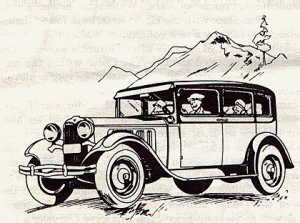 The 1927 Dual Cowl Phaeton is shown. Note the double windshields and hinged steel cover over the rear passengers’ laps.
The 1927 Dual Cowl Phaeton is shown. Note the double windshields and hinged steel cover over the rear passengers’ laps.
But the most important contribution of Detroit to the world goes beyond these tangible effects. It lies in the philosophy of producing more for less. Exported as Fordism to Europe and other parts of the world, this philosophy has done more to bring closer the conquest of poverty than any other contemporary force or animating idea. The advent of mechanization can be painful, breaking up peasant economies and disrupting political institutions, but it also can be the instrumentality for gradually changing underdeveloped countries into developed ones, and for the enlargement of markets. Indeed, the European Common Market, so much in the headlines today, would be almost impossible to visualize had not mass production made its appeal to the French and German mind. From this point of view the expanding world of the Fifties and the Sixties is in a way a continuation of the Twenties when Ford, G. M., and Chrysler raced up what seemed an open and continuous highway before they encountered a dangerous roadblock.
Chevrolet was created in 1914 to sell against the Ford Model T. By 1922 Chevrolet was faring poorly and was about to be dropped, when W. S. Knudsen left Ford and took a leading position with Chevrolet. He improved the design and built up sales until Ford dropped the Model T in 1927.
This Chevrolet,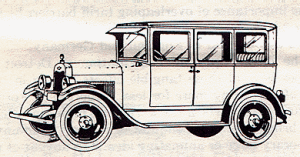 five passenger, four-door sedan was one of Knudsen’s first projects. He enclosed the entire passenger compartment with steel and glass, thus giving it the appearance of a much larger car, plus the added comfort. The car also featured steel disc wheel with detachable rims. The engine was a four-cylinder, water-cooled, 22-hp., inline power-plant of 2,800-cc displacement. Three forward speeds were fitted. An approximate speed of 45 mph. could be reached on the road.
five passenger, four-door sedan was one of Knudsen’s first projects. He enclosed the entire passenger compartment with steel and glass, thus giving it the appearance of a much larger car, plus the added comfort. The car also featured steel disc wheel with detachable rims. The engine was a four-cylinder, water-cooled, 22-hp., inline power-plant of 2,800-cc displacement. Three forward speeds were fitted. An approximate speed of 45 mph. could be reached on the road.
THE END.

